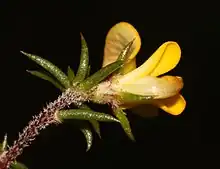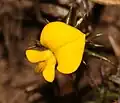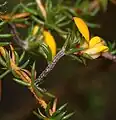| Aspalathus cordicarpa | |
|---|---|
 | |
| Scientific classification | |
| Kingdom: | Plantae |
| Clade: | Tracheophytes |
| Clade: | Angiosperms |
| Clade: | Eudicots |
| Clade: | Rosids |
| Order: | Fabales |
| Family: | Fabaceae |
| Subfamily: | Faboideae |
| Genus: | Aspalathus |
| Species: | †A. cordicarpa |
| Binomial name | |
| †Aspalathus cordicarpa | |
Aspalathus cordicarpa is a species of flowering plant in the family Fabaceae.[2] Prior to its rediscovery in 2016,[3] Aspalathus cordicarpa was last collected in 1950 and thought to be extinct. It is endemic to the Fynbos region around Garcia's Pass in the Western Cape.[1] It is also known as the Heartfruit Capegorse.[3]
Distribution
Aspalathus cordicarpa is found around Garcia's Pass, in sands or sandstone gravel at mid altitudes.[1]
Gallery
Conservation status
As of the 2006 classification, Aspalathus cordicarpa is classified as Extinct.[1] Alien species such as Acacia mearnsii are a severe past and present threat. Pine plantations are also a threat, as the area that Aspalathus cordicarpa is found in has been transformed into pine forestry.[1]
References
- 1 2 3 4 5 "SANBI Red List of South African Plants". South African National Biodiversity Institute Threatened Species Programme. Retrieved 2022-04-16.
- ↑ "Aspalathus cordicarpa". Plants of the World Online. Royal Botanic Gardens, Kew. Retrieved 16 April 2022.
- 1 2 Preez, Brian du (2016-12-01). "Heartfruit Capegorse (Aspalathus cordicarpa)". iNaturalist. Retrieved 2022-04-16.
External links
 Data related to Aspalathus cordicarpa at Wikispecies
Data related to Aspalathus cordicarpa at Wikispecies
This article is issued from Wikipedia. The text is licensed under Creative Commons - Attribution - Sharealike. Additional terms may apply for the media files.



